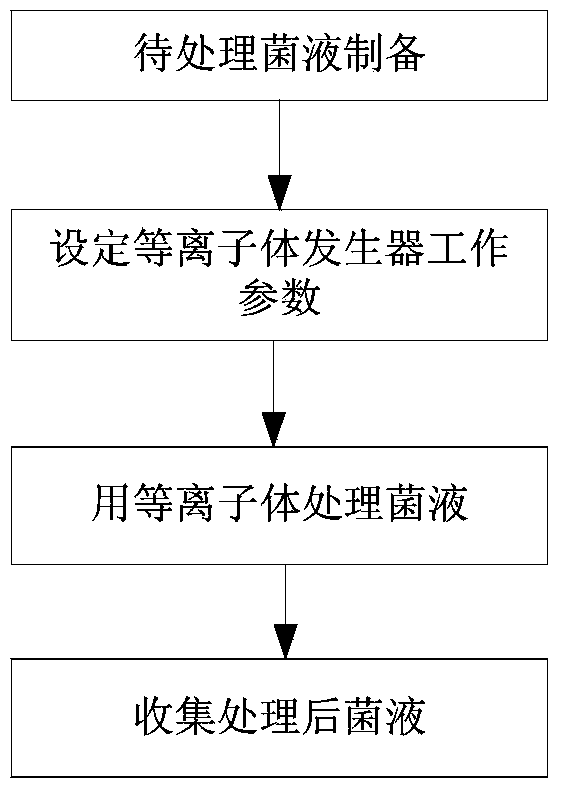Method for preparing microorganism competent cells by using constant-pressure room-temperature plasmas
A technology of competent cells and plasma, applied in biochemical equipment and methods, treatment of microorganisms with electricity/wave energy, microorganisms, etc.
- Summary
- Abstract
- Description
- Claims
- Application Information
AI Technical Summary
Problems solved by technology
Method used
Image
Examples
Embodiment 1
[0036] Example 1: Preparation of Escherichia coli Top10 strain competent cells and determination of transformation efficiency
[0037] 1. Materials and reagents
[0038] Material: Recipient strain E.coli TOP10; Plasmid: pUC
[0039] Reagents: LB liquid medium: peptone 10g, yeast extract 5g, NaCl 10g, distilled water to volume 1L, pH 7.0, sterilized at 121°C for 20min.
[0040] LB solid medium: agar 10g, peptone 10g, yeast extract 5g, NaCl 10g, distilled water to volume 1L, pH 7.0, sterilized at 121°C for 20min.
[0041] 2. Experimental equipment
[0042] ARTP (Atmospheric Room Temperature Plasma) Mutation Breeding System
[0043] 3. Experimental steps:
[0044] 1) Preparation of treatment solution: Pick a single colony on a solid plate growing Top10 strains and inoculate it in 5mL LB liquid medium, and incubate at 37°C for 12-16 hours; Continue to grow in 200mL fresh LB liquid medium to the OD of the bacterial solution 600 0.5; the bacterial solution was divided into 5...
Embodiment 2
[0051] Example 2: Preparation of Escherichia coli DH5α Competent Cells and Measurement of Transformation Efficiency
[0052] 1. Materials and reagents
[0053] Materials: Recipient bacteria E.coli DH5α; plasmid pUC
[0054] Reagents: LB liquid medium: peptone 10g, yeast extract 5g, NaCl 10g, distilled water to volume 1L, pH 7.0, sterilized at 121°C for 20min.
[0055] LB solid medium: agar 10g, peptone 10g, yeast extract 5g, NaCl 10g, distilled water to volume 1L, pH 7.0, sterilized at 121°C for 20min.
[0056] 2. Experimental equipment
[0057] ARTP (Atmospheric Room Temperature Plasma) Mutation Breeding System
[0058] 3. Experimental steps
[0059] 1) Preparation of treatment solution: Pick a single colony on a solid plate growing DH5α strain and inoculate it in 5 mL of LB liquid medium, and incubate at 37°C for 12-16 hours; Continue to grow in 200mL fresh LB liquid medium to the OD of the bacterial solution 600 0.6; divide the bacterial solution into 50mL frozen ce...
Embodiment 3
[0066] Example 3: Preparation of Escherichia coli Top10 strain competent cells and determination of transformation efficiency
[0067] 1. Materials and reagents
[0068] Material: Recipient strain E.coli TOP10; Plasmid: pUC
[0069] Reagents: LB liquid medium: peptone 10g, yeast extract 5g, NaCl 10g, distilled water to volume 1L, pH 7.0, sterilized at 121°C for 20min.
[0070] LB solid medium: agar 10g, peptone 10g, yeast extract 5g, NaCl 10g, distilled water to volume 1L, pH 7.0, sterilized at 121°C for 20min.
[0071] 2. Experimental equipment
[0072] ARTP (Atmospheric Room Temperature Plasma) Mutation Breeding System
[0073] 4. Experimental steps:
[0074] 1) Preparation of treatment solution: Pick a single colony from a solid plate growing Top10 strains and inoculate it in 5 mL of LB liquid medium, and incubate at 37°C for 12 to 16 hours; Continue to grow in 200mL fresh LB liquid medium to the OD of the bacterial solution 600 0.5 to 0.7; divide the bacterial solu...
PUM
 Login to View More
Login to View More Abstract
Description
Claims
Application Information
 Login to View More
Login to View More - R&D
- Intellectual Property
- Life Sciences
- Materials
- Tech Scout
- Unparalleled Data Quality
- Higher Quality Content
- 60% Fewer Hallucinations
Browse by: Latest US Patents, China's latest patents, Technical Efficacy Thesaurus, Application Domain, Technology Topic, Popular Technical Reports.
© 2025 PatSnap. All rights reserved.Legal|Privacy policy|Modern Slavery Act Transparency Statement|Sitemap|About US| Contact US: help@patsnap.com

